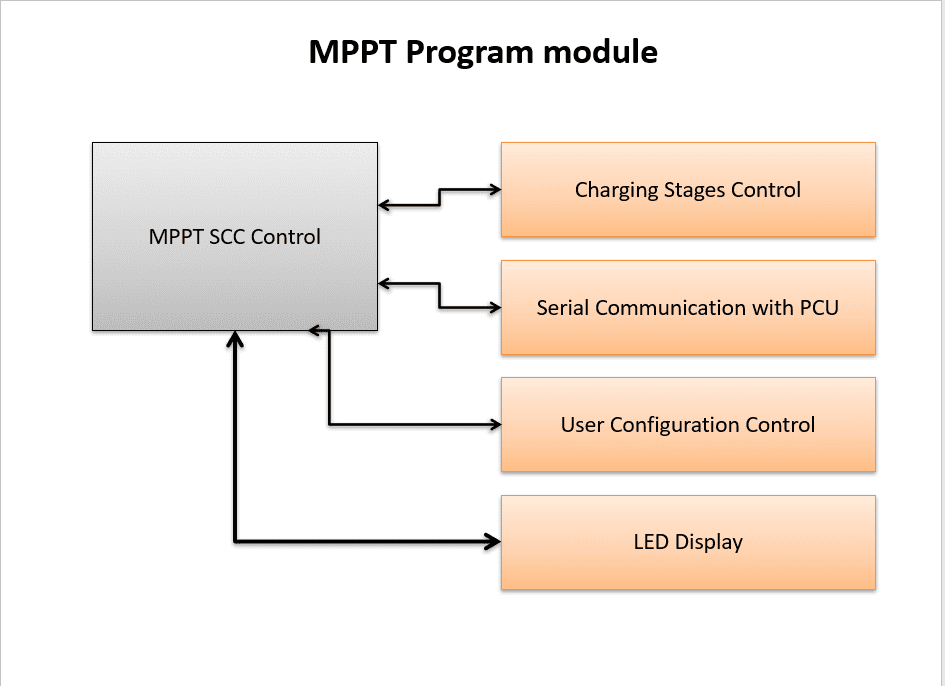
Maximum PowerPoint Tracking, frequently referred to as MPPT is an electronic system that operates the Photovoltaic (PV) modules in a manner that allows the modules to produce all the power they are capable of. MPPT is not a mechanical tracking system that physically moves the modules to make them point more directly at the sun. MPPT is a fully electronic system that varies the electrical operating point of the modules to deliver maximum available power.https://en.wikipedia.org/wiki/Maximum_power_point_tracking

solar panel graph
MPPT charge controllers offer several benefits over PWM charge controllers, including:
- Increased charging efficiency: MPPT controllers can increase the charging efficiency of a solar system by up to 30%. This is because they track the solar panel’s maximum power point (MPP) and adjust the voltage and current accordingly. In low-light or cold conditions, where the solar panels produce more voltage than the battery bank can handle, MPPT controllers can still extract the maximum power from the panels.
- Flexible design enables the user to use panel and battery rating as required.
- Smart MPPT tracking algorithm to provide a current boost of up to 30%
- Faster charging of the batteries compared to the PWM Charge controller
- Temperature-compensated Battery charging to protect the battery
- Auto/Manual Periodic Equalization charging for reducing the lead Acid battery sulfation and enhancing life.
- Increased power output: MPPT controllers can also increase the power output of a solar system by up to 30%. This is because they can track the MPP of the solar panels and adjust the voltage and current to match the changing conditions of the solar irradiance and temperature.
- Reduced wire size and length: MPPT controllers can operate at higher voltages and lower currents than PWM controllers. This can reduce the wire size and length between the solar panels and the battery bank, saving money and installation time.
- Compatibility with more solar panels: MPPT controllers are compatible with a wider range of solar panels than PWM controllers. This is because they can track the MPP of solar panels with different voltage and current characteristics.
- More features: MPPT controllers often have more features than PWM controllers, such as temperature compensation, load control, and battery type selection. These features can make MPPT controllers more versatile and user-friendly.https://suvastika.com/maximize-battery-life-in-ups-inverter-by-having-atc-feature-for-charging-lead-acid-batteries/#:~:text=ATC%20monitors%20the%20battery%E2%80%99s%20temperature%20and%20adjusts%20the,the%20battery%20from%20overheating%2C%20leading%20to%20premature%20degradation.

- Lithium battery compatibility: The new MPPT-based charge controllers are compatible with Lithium battery charging through solar panels.https://suvastika.com/lithium-battery-option-in-inverter-ups-solar-pcu/#:~:text=We%20at%20Su-vastika%20have%20provided%20our%20inverter%2FUPS%2FSolar%20hybrid,only%20connect%20Tubular%20SMF%20and%20lead%20Acid%20batteries.
Overall, MPPT charge controllers offer several benefits over PWM charge controllers. If you are looking for the most efficient and powerful way to charge your solar batteries, an MPPT controller is the best option.
Here are some additional considerations when deciding whether to use an MPPT charge controller:
- The size of your solar system: MPPT controllers are typically more expensive than PWM controllers. However, the cost difference may be offset by the increased efficiency and power output of an MPPT controller. If you have a large solar system, then the cost of an MPPT controller may be worth it.
- The climate you live in: If you live in a cold climate, then an MPPT controller is a good option. MPPT controllers can extract more power from solar panels in cold conditions.
POWER SECTION: The power Section consists of a Buck converter, a DC-DC Converter used to Step down the Panel Voltage to charge the battery with the maximum current. Because the duty cycle of the buck converter Will be decided according to the Vmp and Imp Of the solar panel.https://suvastika.com/difference-between-mppt-and-pwm-solar-charge-controller/
MPPT Solar Charge Controller has the Four Stage Battery Charging Process (Bulk, Absorption, Float, Equalization)
MPPT charge controller has this Protection Against
Reverse Battery Connection
Surge Protection
Ambient Temperature Compensation
Heat Sink Temperature Compensation
Reverse Battery Current Flow Protection
PV High Current Protection
Overload and Short Circuit Protection
Conclusion: MPPT Solar Charge Controller increases the efficiency of solar panels.
